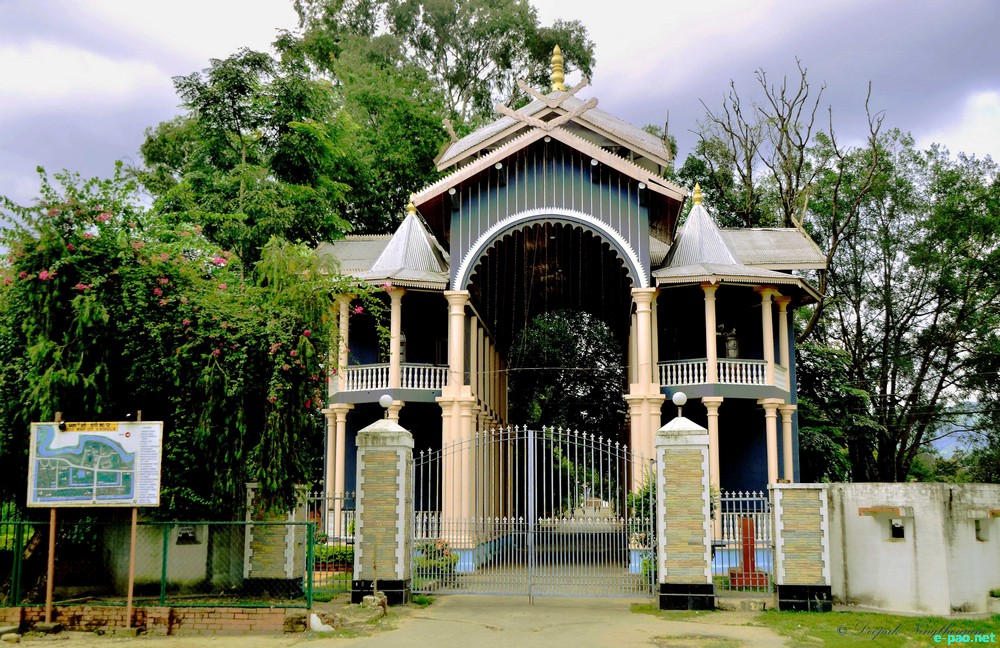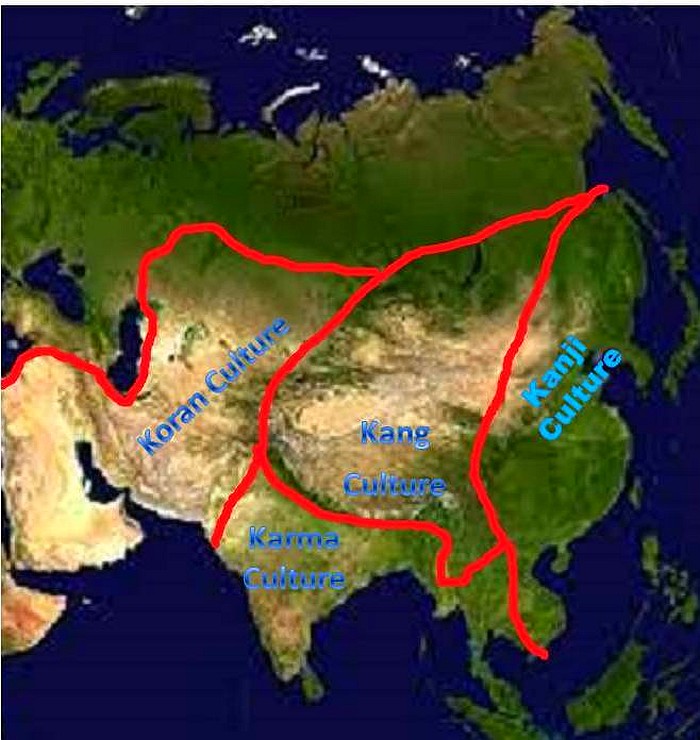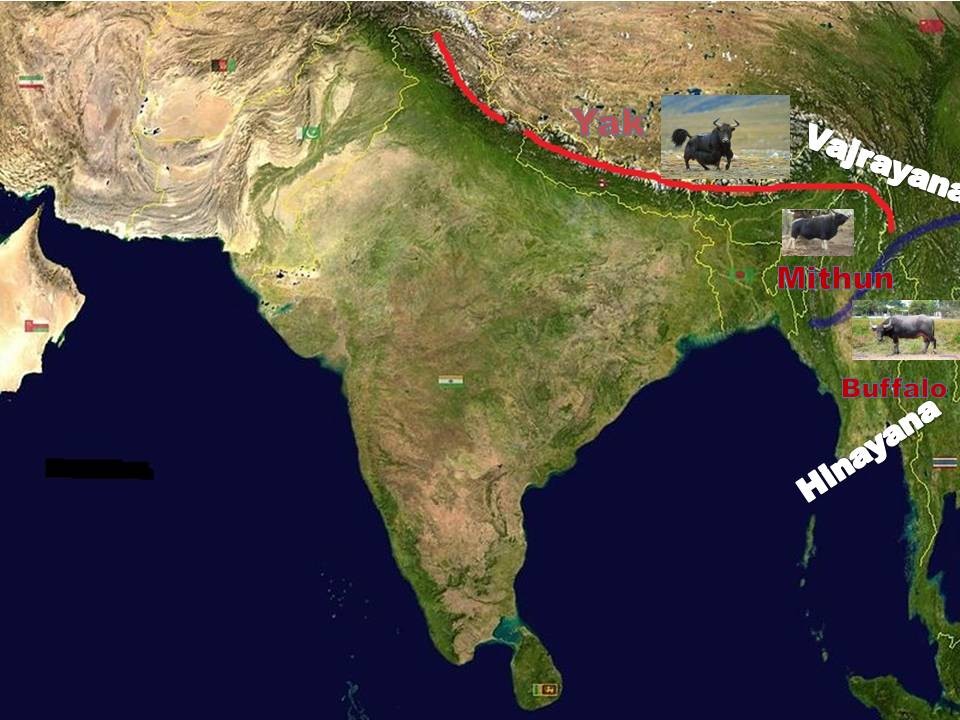Imphal's Kangla To Ladakh's Kangla - Postulating A Kang Culture Belt
Niraj Kumar, Chingngaih Biak *

Kangla - A place where the Kingdom of Manipur was established :: Pix - Deepak Ningthoujam
There are certain strange coincidences in the Himalayan belt. The Himalayas extend from the Karakoram mountains in India's north to the Liangshan in the east. Dhaulagiri bisects Himalayas into two equal halves. If on the north-western extremity of this chain lays the culture sub-region of Kashmir and Ladakh, on the south-eastern extremity of Eastern Himalayas exist the culture of Zomis/Mizos.
At both end of the belt, there are common stories about origin, movement and ecology, though the geo-climatic characteristics changes drastically. Kashmir valley derives its name from Prakrit roots. The component kas means a water channel and mir is the mountain. Thus, Kashmir is the land fed on by water from mountain, indicating about various water streams and lakes. Similarly, zomi people claim that they had settled in the valley of Tuikang or Chindwin valley, where they lived with the Shans. Tui is water and Kang is homonym with multiple meaning like mountain, white, best, highest, pure, supreme. Tuikang will therefore mean same as Kashmir-water from mountains.
But, a particular word that pervades the languages of whole Himalayan range is Kang. This is to be found among the Ladakhis in the north and among the Mizos in the south-west end of the zone. Stok Kangri(6116 mt) and Kang Yatse(6200mtr.) are the well known mountain peaks in Zanskar region in Ladakh. One crosses Ladakh and enters eastward into the Miyar valley of Lahaul-Spiti by crossing the Kang-la Pass. It is one of the most remote passes in the Himalayan belt and located at 5468 Metres above sea level. As soon as one crosses into Himachal, he reaches the sacred land of Kang-ra district where temples of many of the Saptamatrikas like Chamunda, Kangra, Jwalamukhi Devi, Naina Devi, Chintpurni are situated.
Further north, the most sacred mountain, the Kailash is known as the Kang Rinpcohe by Tibetans. Kailash is also the home to major river systems of Asia. The river which journeys along with the Himalayas through great bend towards the Bay of Bengal is the Brahmaputra. Its origin is from the glacier of Kabab Kangri. Further eastwards, the highest mountain of the world, Mt. Everest (8848 mtr.) is known as the Lepchi Kang by the Tibetan worshippers. Further east, Kangchendzonga (8598 mtr.) , the third highest mountain peak in the world is important for the people of Sikkim. At the far eastern extremity, the highest mountain peak of Yunnan is the Kang Karpo (6840 mtr.). All these high mountain peaks are permanently snow-capped and hence also 'kang' in another meaning (white). These are the highest summits providing the word kang with another meaning.
Such is the popularity of the term, Kang, from Ladakh to Manipur, that this word might become the key to unlock hidden linkages. In Manipur, the Meitei's term their land as 'Kangleipak'. Many revivalist groups are indulged in militancy for restoring their Kangleipak. In Kuki dominated- Senapati district, one comes across the highest peak, Kala Pahar, in the Kangpokpi sub-region. This area is full of Kang-nomenclatures. There is Kokang town, Kangta and Kanggui village. In fact, Kokang is a large town in Northern Myanmar and it appears that the memory of landscape has been transposed by the Kuki communities in the Kangpokpi sub-region.
In fact migrations stories of many of these communities mention about their origin from the region of Kangtui, which most of the modern scholars identify with the Chindwin river valley in Myanmar. But, Kangtui carries the meaning of "stream from white snow mountains", and there are no snow mountains in the middle part of Myanmar. Therefore, this may be indicative of the region around Mt. Kang Karpo which is snow-laden and like Kala Pahar peak in Kangpokpi district in Manipur, always covered with clouds. Kang Karpo ("The White Pillar Snow Mountain") lies in the Hengdusn Shan Mountains running north-south covering the region of convergence of Tibet, Yunnan, Sichuan and Myanmar. When one moves to the nearby mountains of Yading, one gets amazed at the view of three sacred peaks, Chenrezi, Jampayang and Chenadorje surrounding Kang-Karpo.
In fact, this region is most likely to be the place of origin of these ethnic groups. Migration of Tibeto-Burman people, particularly Chin-Kuki-Naga groups through any pass, would not have missed this important geographical landmark. Probably, the presence of Three sacred peaks had pre-Buddhist significance, particularly for indigenous groups like Chin-Kuki-Naga, whose identity itself is intertwined with the "mountains". This memory is reflected in widely accepted belief that all the people who cook rice on three stone pillars, "Lungthu", are all zomi/Mizo. Naga ancestors erected three stone monoliths in the village of Makhrai-Rab, called Linotu, signifying the three pillars of human life.
For the Meitei Manipuri, who also belongs to the same stock as that of the Chin-Kuki-Naga, Kangla Fort in Imphal is the symbol of identity. Manipuris who are credited with discovering the game of Polo, locally calls the game as Sagol Kangjei. The royal household plays another game of Kang Shanaba in which the male and female members participate wearing traditional attire. In such usage, Kang carries the meaning of the majestic and precious.
The identification of kang with the white colour of snow is so strong that when the British administrators started visiting the area after conquering these territories, villagers treated them with obsequious respect. Because they were white they were called mikang topa meaning White Master or Lord. Mi is people, kang is white and topa is the lord, so British were identified as the Mikang Topa.
But, Kang is used as a highly reverential word, more among the Tibetans. For the Himalayan Buddhist, the words of Buddha are compiled in the Kang-gyur. Kang in this context is the term for "the most precious, pure as white" and gyur is the transmission. The stone pillar in Lhasa which is the symbol of Tibetan nation is Jo-khang, and clearly derived from this word. The highest peak near Lhasa is Mt. Noijin Kangsang (7,206m). But, the term is exclusively used by all Tibetans for the most revered mountain peak on the planet, Mt. Kailash. This is the Kang Rinpoche, the most precious mountain peak. The Kailash Purana of Tibetans is known as the Kang-Kangri.
After surveying the usage of the term among different sub-families of Tibeto-burman language, it can be postulated that a Kang-culture pervades the Himalayas from Ladakh to Manipur-Nagaland covering Yunnan, Sichuan in China and Northern Myanmar. This Kang-culture is based upon the worship of mountain peaks and celebrating the lives sustaining on the water streams gushing from those hills. Kang culture also spread to Mongolia and Buddhist region of Russia's East along with the influence of Himalayan Buddhism.
Once Kang-culture belt is properly studied, Asia can be viewed as packed with slices of contiguous culture stripes. In East Asia, there is a Kanji culture of common script covering China, Japan and Koreas and many parts of South-East Asia. Thence, Kang-culture zone in the underbelly of the Himalayas. There is Karma-culture zone in India that believes in karma, rebirth and cyclicity of phenomena. Further west, it is Koran-culture zone in the Middle East and Central Asia. (Figure 1)

Figure 1: Asia's Cultural Stripes
But, Kang-culture centred upon reverence towards the snow-capped inaccessible high mountain peaks, which were believed to be the abode of their gods, has been deeply influenced by Buddhism. Buddhism in its two forms acted as the pincer movement. While Vajrayana Buddhism grew from northward down, Hinayana Buddhism grew southward north. Two forms of Buddhism meet in Yunnan province of China, which is distinct region with presence of more than 20 ethnic groups in China. Kang culture is facing further pressure from Catholic Christianity. But, it is still only a century of invaginations.
Naga Hills retain the remnants of ancient Kang culture to a large extant because of many peculiarities. Naga Hills were least annexed by the British authorities. Moreover, the fear of head-hunting tradition of Nagas made them less touched with outside people. Nagas themselves evolved distinct characteristics of dialectical variation to preserve ethnic-cum-spatial identity. In Ukhrul district of Manipur dominated by Tangkhul Nagas, there are more than 200 dialects. Each village has distinct dialect and makes interaction mutually unintelligible. Nagas constitute the cockpit of Kang culture now. Flanked by the northern stream of yak-based society and southern stream of buffalo-domesticating society, Nagas have their own distinct animal, Mithun( Bos frontalis). Mithun is a cross breed of gaur and domestic cattle and known as Sial or Kikang(another instance of importance of term Kang). Nagas bifurcate two different world views, two different domesticated-animal landscapes. (Figure 2)

Figure 2: Sandwiched Nagas
This situation allows getting a peep into the pristine Kang culture by reading Naga history. But, they do not have written history, nor have they built memorial of their civilization. How can social scientists peep into Naga worldview and Naga history? Increasingly, the realization has come that history of written history is very short. When population geneticists are trying to explore human prehistory by examining mitochondrial landscape, a flurry of methods have been discovered by anthropologists to read history through more permanent objects�materials of ritual and everyday use .It will be a daunting task for social scientists to explore the common characteristics of this Kang Culture by reading and rereading the materiality shared across the Himalayan belt.
* Niraj Kumar, Chingngaih Biak wrote this article for e-pao.net
Niraj Kumar is the author of several books. His recent published work is "Asia in Pot-Western Age"(2014).Chingngaih Biak hails from Churachandpur and a keen explorer of Zomi community.
The writers can be contacted at kniraj14(at)yahoo(dot)com and biak_c(at)yahoo(dot)com
This article was posted on September 03, 2014.
* Comments posted by users in this discussion thread and other parts of this site are opinions of the individuals posting them (whose user ID is displayed alongside) and not the views of e-pao.net. We strongly recommend that users exercise responsibility, sensitivity and caution over language while writing your opinions which will be seen and read by other users. Please read a complete Guideline on using comments on this website.








